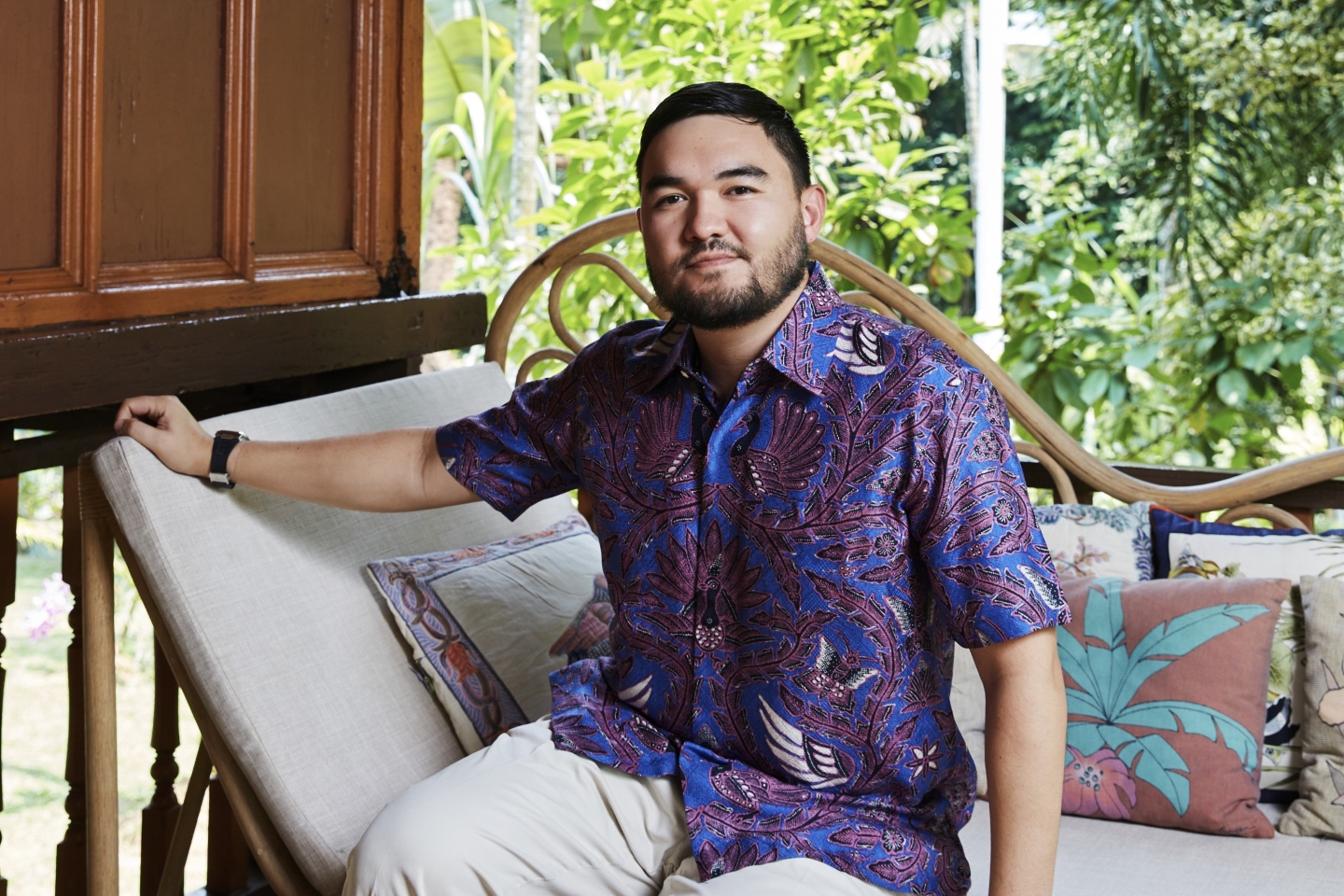
Tengku Amir: The entire experience is like an unforgettable life lesson. It shows you how everything boils down to your mental attitude. (Photo: SooPhye)
Everyone with a working conscience knows how important it is to give back in life. From practising kindness whenever we can to volunteering our time and skills for a good cause, every action — big or small — resonates positively. But when purpose is added to the equation, one would invariably find the experience blessed with greater meaning, as was the case when the Crown Prince of Selangor, Tengku Amir Shah Sultan Sharafuddin Idris Shah, agreed to lead an expedition to the world’s highest single free-standing mountain, Kilimanjaro.
Locals attribute Kilimanjaro’s name to the Swahili words for “mountain of greatness”. A dormant stratovolcano located in Tanzania’s Kilimanjaro National Park, Mount Kilimanjaro is also Africa’s highest peak, standing at 5,895m above sea level and comprising three distinct volcanic cones: Kibo, the highest; Mawenzi; and Shira, the lowest. Although it is a popular destination among climbers, seasoned mountaineers will tell you that any great peak is never to be taken lightly.
For a better future
Perhaps the acclaimed high-altitude mountaineer Nirmal Purja of Project Possible 14/7 fame, who successfully ascended all of the world’s 14 eight-thousanders (mountains over 8,000m above sea level and sufficiently independent of neighbouring peaks) in seven months, including climbing Mount Everest, Lhotse and Makalu in two days and 30 minutes, says it best: “The mountain doesn’t say you are black, you are white, you are weak, you are strong. It’s one rule for everybody. If you give up, you die.”
Kilimanjaro National Park, naturally, has put up signs all over, warning climbers to not push themselves to higher altitudes should breathing problems, headache or any other symptoms of mountain sickness appear, some going so far as to state how “descent is sometimes the better option”. And Kilimanjaro, although not an eight-thousander, still claims an average of 10 lives each year. Climbers will also tell you bluntly how Kilimanjaro is said to be tougher than Everest Base Camp, which is located at 5,364m, due to how quickly one climbs to higher altitudes at the former, with 3,600m being the standard gain.
Despite being fully aware of the risks, Tengku Amir was in with the idea from the get-go. “What led me to agree to leading this expedition to Kilimanjaro was that the group comprised mostly family. And also because it was family who brought us and the idea together initially.” By this, the 33-year-old Raja Muda is referring to his cousin and fellow climbing buddy Datuk Syed Haizam Jamalullail, whose daughter was diagnosed with hearing impairment at the age of three and had to undergo cochlear implant surgery when she was four. “Haizam has been through quite a difficult challenge to support his eldest child, Sharifah NurAlara. Thankfully, she is now well and able to rejoin normal school activities and such. But we realised how a lot still needs to be done to raise awareness of childhood hearing loss or impairment, not to mention having access to treatment, the cost of which alone is a barrier for many Malaysians.”
mount_kilimanjaro.jpg
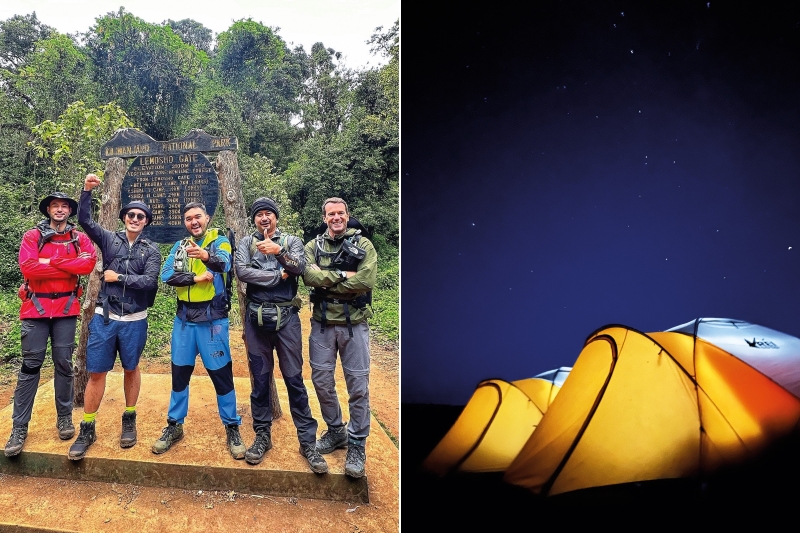
So, together with Syed Haizam, brother-in-law Datuk Setia Aubry Rahim Mennesson, Tengku Ezrique Ezzuddean Tengku Ardy Esfandiari and Keong Yeen Yeoh, the prince set out on the fundraising expedition to Kilimanjaro in early September, returning in time to celebrate Malaysia Day. “My brother-in-law and cousins probably put their trust in me as team leader due to my years in the army,” he jokes, referencing his days at the UK’s prestigious Royal Military Academy Sandhurst after which he worked his way through the Malaysian Army, becoming a captain in 2020. “They thought me capable of reading the maps, so we don’t get lost off-trail and at least getting us close to — if not to — the top. And 2023 also marks Haizam’s 40th birthday. What better way to celebrate the milestone year than with an adventure?”
The big ‘why’
The seeds of Team Selangor’s route to Kilimanjaro were actually sown a good decade ago. “It was way back in 2012 when I had taken part in a climb up Mount Kinabalu with Selangor Cheshire Home, of which I am royal patron,” the Raja Muda explains. “For those who don’t know Cheshire, the 60-year-old home provides residential care to permanently disabled individuals who have no resources or other means of income as well as helps others gain employment skills. Somehow we had the idea of bringing 20 young people, with mental as well as physical disabilities, up Kinabalu. The objective was to show them that, despite being differently abled, anyone, everyone, can achieve that pinnacle … that they too can dream big!”
Although logistically and physically challenging, the expedition to Sabah was nonetheless a success. “We had a 1:1 ratio of volunteers per climber and both Aubry and Haizam were there too. Once we achieved what we had set out to do, we were all overwhelmed by a sense of amazement and inspiration. We realised how no one needs to be limited by their limitations. So, buoyed by that, the thought quickly went from the highest mountain in Southeast Asia to the highest one in Africa. I had never visited the continent at that point and even until this recent trip, had only ever been to North Africa.”
The years went by and somehow Tengku Amir always kept the idea of Kilimanjaro at the back of his mind. “I never brought it to light because there wasn’t a good reason to. I didn’t have the big ‘why’. It was only after hearing what my cousin went through with his daughter and when the idea of building a new speech and hearing aid centre at the Raja Tun Uda Library in Selangor — which already offers enhanced facilities to enable the differently abled to access the library collections — came about that I knew the big ‘why’ was answered.” Once complete, the new speech and hearing aid centre will offer free hearing tests as well as subsidised follow-up treatments to complement the library’s already inclusive set-up, furthering its founding values, which include sharing and spreading the joy of the written word with one and all. “Yeah, so that goal brought it all together. Right now, we are looking at raising RM1 million.”
image_6483441.jpg

Road to Kilimanjaro
With Aubry, the husband of his elder sister Tengku Zatashah Sultan Sharafuddin Idris Shah, having all six of the World Marathon Majors under his belt, it did not surprise the prince that the Frenchman’s answer was an immediate “yes” when asked if he would join the group. “Haizam, of course, was in as well. Yeen and Ezrique also said yes when we asked them if they were willing to challenge themselves in the name of charity.” The military-minded royal then immediately set about putting everyone through two months of intense preparation and training every weekend. “We roped in some coaches for guidance as well. We did everything we could, except altitude acclimatisation because, let’s face it, even the highest mountain in the peninsula, which is Gunung Tahan (2,187m), comes nowhere close to offering altitude sickness levels. But I made sure we trained hard and got used to hiking with heavy loads because we knew we were going to carry at least 3kg of water daily on top of our other supplies.”
Given all the risks and hardship involved, we asked how the Crown Prince obtained permission from his father, the Sultan of Selangor, to embark on this journey. “I think Tuanku has been accustomed to me putting him through worry from the time I was 19 and backpacked for three months through South America, to Bolivia, Peru and Colombia,” he grins. “I was on a very tight budget and stayed in hostels that averaged €2 a night. But to be fair, Tuanku has gone on some epic trips himself (Sultan Sharafuddin Idris Shah drove a Proton Saga from Kota Kinabalu to Kuching in 1986; circumnavigated the globe on a 22-month sailing expedition in 1995; and participated in the legendary Peking To Paris Motor Challenge, driving his 1932 Ford Model B and covering 16,000km in 43 days, among other adventures) so that made it sort of okay. But we did present to him our plans and explained how a professional company was involved, from the guides to the camping set-up and all. It wasn’t just going to be us five amigos!”
After arriving at Dar es Salaam with another hour’s flight to Arusha, the quintet set out on the final leg of their approach towards the mountain, which involved a three-hour drive through beautiful bushland to reach Kilimanjaro National Park. Opting for the Lemosho Route, an eight-day trek (seven days to ascend and one-and-a-half to descend) with a starting elevation of 2,100m awaited. It is said to be one of the most beautiful routes leading to Kilimanjaro’s summit as it crosses the whole of the Shira Plateau from west to east and cuts through rainforest populated with black-and-white colobus and blue monkeys and a rich array of flora and fauna before reaching forbidding alpine desert landscapes.
img_7684.jpg
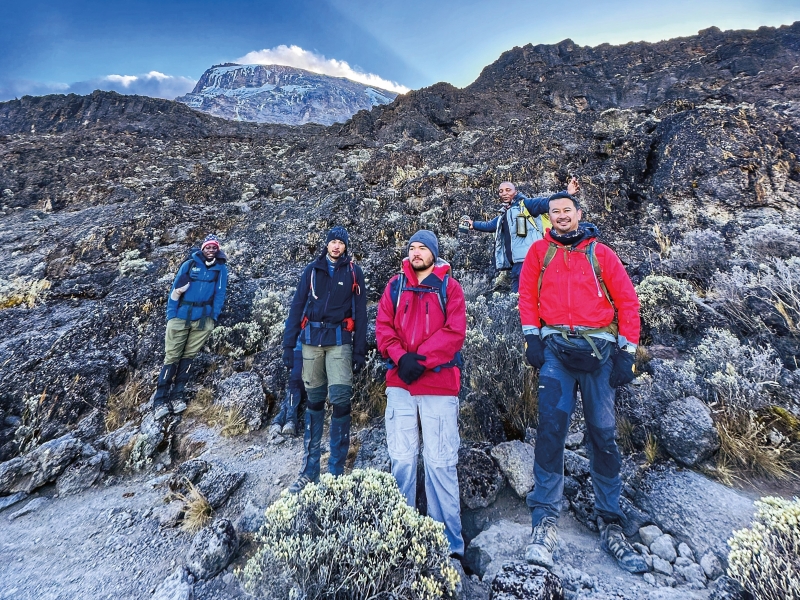
Kita boleh!
“Part of the challenge was the fear of the unknown. I mean, we had arrived in Tanzania and we couldn’t even see the peak while driving towards Kilimanjaro. It’s not a typical mountain with an obvious crest or crown. It just looked like a big piece of land covered by clouds,” Tengku Amir explains. “The other challenge was knowing that after day one, there were still so many more days and kilometres to go. Also, there was the daily challenge of waking up in the cold, and having to motivate not just yourself but everyone around you. I must stress how fortunate we were to have a first-rate team of professional guides and porters supporting us, all of whom were just so cheerful and helped us every step of the way. I mean, we’d be struggling at 5,000m and they’d be there singing their lungs out. We couldn’t emulate them, no way, but their cheerfulness and resilience really encouraged us.”
Tengku Amir adds how having their own team slogan or mantra helped. “In Kilimanjaro, the traditional chant is pole, pole which means ‘slowly, slowly’. The guides will tell you to pole, pole because there is no race to be run. If you want to get to the mountain, you need to take your time. You can’t overexert. You need to rest, eat. We decided to Malaysian-ise our chant slightly to kita boleh (Malay for ‘we can’). The guides burst out laughing as it sounded like Swahili for ‘to open something’. They kept asking what we wanted to open!”
Besides the thrill of the summit, every single day yielded knowledge and insight into a different world and way of life. In fact, Kilimanjaro offers five unique ecosystems, most with flowers, plants and trees that can be found nowhere else on the planet. “Our guides were so knowledgeable … one kept pointing out all the different plants; which ones were good to help with skin infections and another called the ‘peace’ plant, which you extend, not unlike an olive branch, if you wanted to settle a dispute.”
As makan-loving Malaysians, it was inevitable that the subject of rations would come up and Tengku Amir good-naturedly shares how it was “a lot of carbs! It was more vegetarian than expected but good. We had lots of root vegetables to eat and soup to drink twice a day. We were so grateful when the guides made us chapatti one day! Someone had brought along a bottle of Sabasco — you know, the Sabahan take on Tabasco sauce — and they noticed how we liked chilli. After that, they started making everything spicy, from the samosas to the beef stew. I must also add how the least experienced hiker in our group — I’m not saying who — brought along a big bag of electrolyte sachets! But it’s true … whenever you engage in physical endurance, food is the best and easiest way to keep you going. We even brought Milo along — which was really nice to have in the cold mornings. And you know what, despite the climbing and trekking, I actually gained weight due to all the eating!”
image_6483441_2.jpg
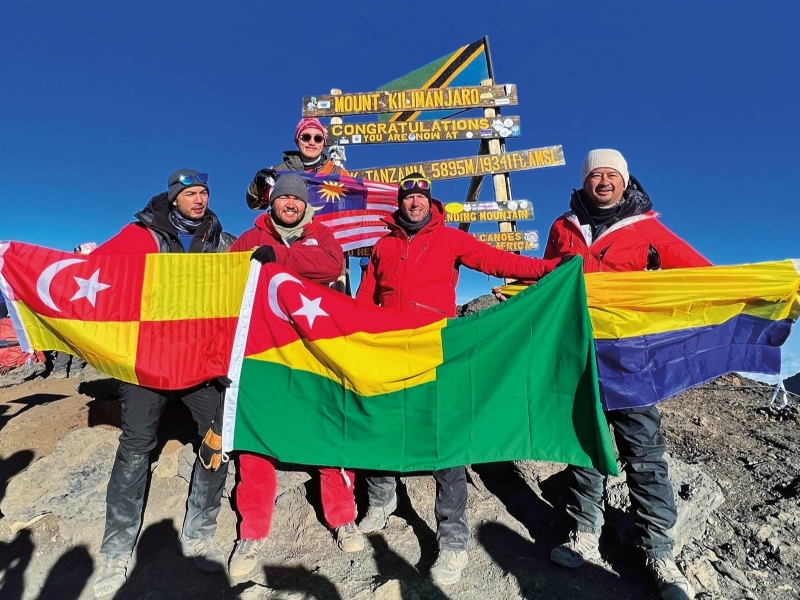
Summit day
The final leg of the ascent consisted of a gruelling six-hour climb in the darkness on day seven, beginning from midnight, and going from an elevation of 4,600m to 5,895m where the peak of Kilimanjaro, Uhuru, whose name means “freedom”, awaited. “This was hard as we started off the climb having far less sleep than usual. Then you add stress and nervousness to it all. If you ask me, the most stressful days were day one and day seven. Everything in-between was very fun,” Tengku Amir says, completely deadpan.
“But the entire experience is like an unforgettable life lesson. It shows you how everything boils down to your mental attitude. I can honestly tell you I felt the struggle in the last hour. I mean, I could see the crest by then but it was still like 300m to go, which equated to another good hour-plus of climbing. At that point, I actually had to say it out loud to myself, how every step is a step closer to glory, to success, in order to keep going. By now, the oxygen levels were halved. We were cold. We were exhausted. Every step we took was a very, very small one, literally baby steps because we were mentally and physically drained. Also, hiking in the dark is a different mental ball game as well. Why? Because you don’t know where you’re going. You can’t see where you’re going. All you can do is pray for sunrise. So suddenly when the first rays hit … that feeling of joy and relief is indescribable.”
Prior to Uhuru, climbers need to first reach Stella Point, which stands on the edge of the crater’s rim at an altitude of 5,756m. And although all climbers who reach this point automatically qualify for the official Kilimanjaro climbing certificate, the determined ones know they need to power through to Uhuru, just another 139m higher. “I remember cheating myself by saying ‘We’re almost there. We’re almost there’, despite knowing full well there were another three hours to go. I remember asking one of the guides: Are we there yet? Is that the crest? To which he answered: Do you want the honest truth or do you want me to lie? I said, ‘For sure I want you to lie.’ So guess what? He just kept quiet! But two of our guides were named Moses and Ishmael, which we took as good omens as we had two ‘prophets’ to lead us to the promised land of Uhuru,” he laughs.
It was also inevitable that thoughts of giving up and turning back would plague the team from time to time. After all, by now, they would have had to bypass groups who decided not to push on or, worse, as Tengku Amir recalled, people vomiting and retching by the side of the trails or just scenes of climbers struggling and getting weak, in general. “It was definitely hard to see. Because then it plays in your mind. And it really affects you when you see younger people struggling and suffering because of the fear it is going to happen to you as well. So I would say part of the challenge in climbing Kilimanjaro is to not be overconfident and yet have enough faith and mental strength to go the distance. You really have to be self-aware and conscious enough to bury those niggling doubts, fears and thoughts of surrender.”
image_6483441_3.jpg
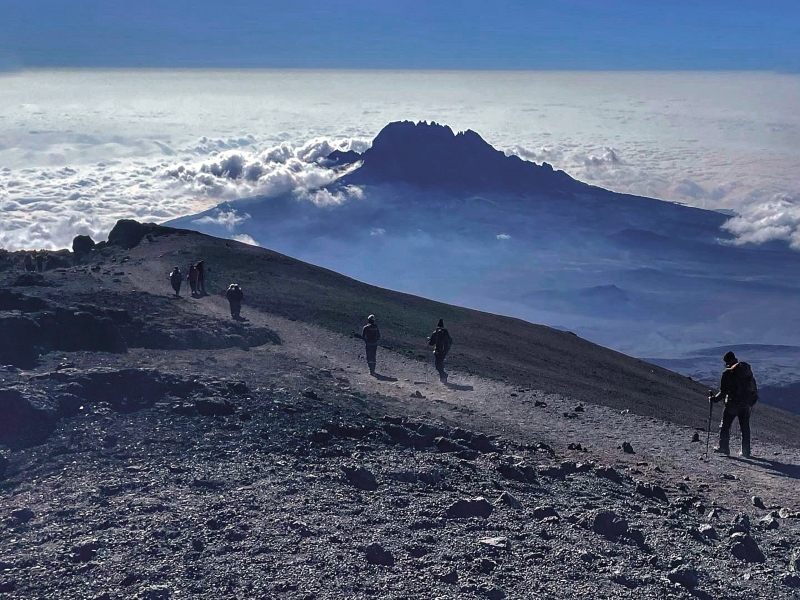
Back to earth
For all the jubilation being on the roof of Africa, Tengku Amir is equally quick to burst the bubble. “It is about 10am, the sun is shining, and we had just made it to the summit of Kilimanjaro. But guess what? Moses comes to tell us we only have half an hour to enjoy the moment before making our way down. It was heartbreaking,” he says, half-jokingly. “But we were happy trudging back down and getting to the Bon Voyage signboard where more singing and dancing awaited before being given one hour to pack up and leave. Brutal!”
Thankfully, a few days in a nice lodge within Arusha National Park awaited the five. “It was beautiful being surrounded by nature and greenery once more, after the starkness of the mountaintop. Here, I conned the group into going on one more hike as I felt my legs cramping up. You can’t do static recovery. You need active recovery after putting your muscles through hell for eight solid days, so I tricked them into a long hike around the lake with me. But I would definitely climb with these four again. It’s been fun. There was no negativity. Everyone had the right energy.” And as to which mountain peaks and valleys might be considered in the future, Tengku Amir says, “Obviously Everest Base Camp has cropped up in the conversation, as well as Aconcagua in South America. But like I said before, we need to find the right reason. The big ‘why’ is all-important for whatever endeavour we wish to embark on in our lives. Big things need to go beyond personal goals.”
When asked what advice he would share with others who wish to conquer mountains, literal or figurative, the prince mulls for a minute before answering: “Don’t over-study what you set out to do. Too much knowledge can sometimes be a hindrance. Be realistic and set goals … as small as possible, if necessary. Break it down. I think Kilimanjaro taught us all a good lesson on how we rush around too much in life. We need to be reminded that, as clichéd as it sounds, the journey should be enjoyed as much as the destination.” Pole, pole indeed.
To donate towards the new Speech & Hearing Aid Centre at the Raja Tun Uda Library of Selangor, visit simplygiving.com or email [email protected] for more information.
This article first appeared on Oct 9, 2023 in The Edge Malaysia.


